Atrust T66 User Manual
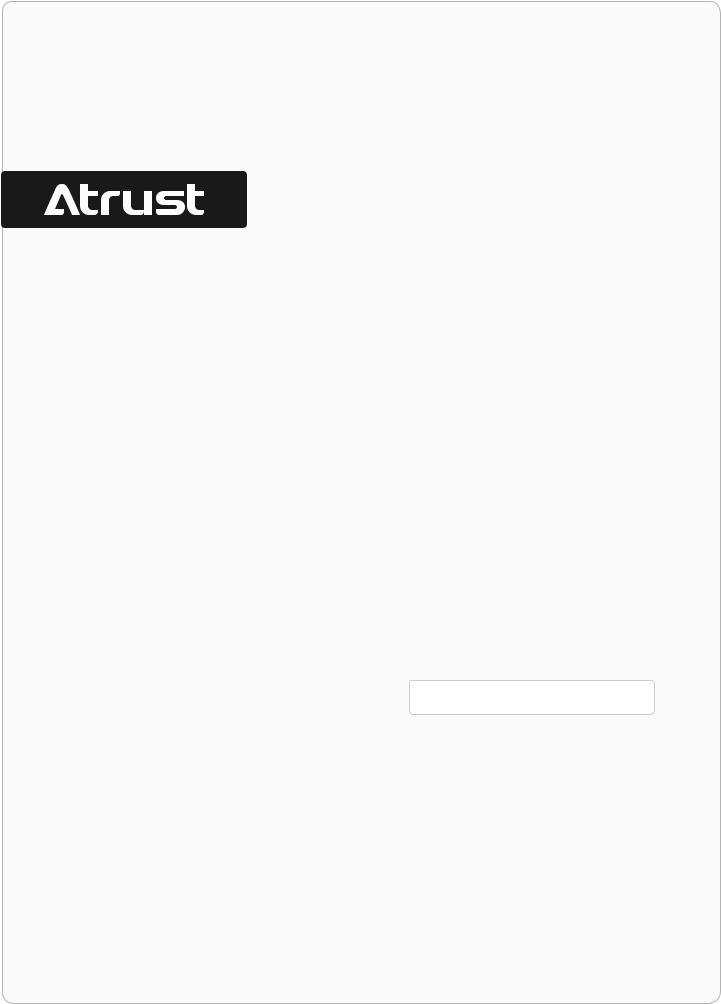
Atrust t66 Thin Client
USER’S MANUAL
Internal Draft 0.05
Copyright © 2014-17 Atrust Computer Corp.
UM-t66-EN-17022019

i
Copyright and Trademark Statements
Copyright © 2014-17 Atrust Computer Corp. All rights reserved.
This document contains proprietary information that is protected by copyright. No part of this document may be photocopied, reproduced, or translated to another language without the prior written consent of Atrust Computer Corp.
Disclaimer
Atrust Computer Corp. (“Atrust”) makes no representations or warranties with respect to the contents or use of this document, and specifically disclaims any express or implied warranties of merchantability or fitness for any
particular purpose. Atrust is not liable for technical or editorial errors or omissions contained herein. The information in this document is subject to change without notice.
Trademark Statements
Atrust is a trademark of Atrust Computer Corp.
Microsoft, Windows, Windows Server, RemoteFX, and MultiPoint are trademarks or registered trademarks of the Microsoft group of companies.
Citrix, ICA, XenApp, XenDesktop, and VDI-in-a-Box are trademarks of Citrix Systems, Inc. and/or one or more of its subsidiaries, and may be registered in the United States Patent and Trademark Office and in other countries.
VMware, VMware View, and VMware Horizon View are trademarks or registered trademarks of the VMware, Inc.
PCoIP is a registered trademark of Teradici Corporation in the United States and/or other countries.
Other product names mentioned herein are used for identification purposes only and may be trademarks and/or registered trademarks of their respective companies.
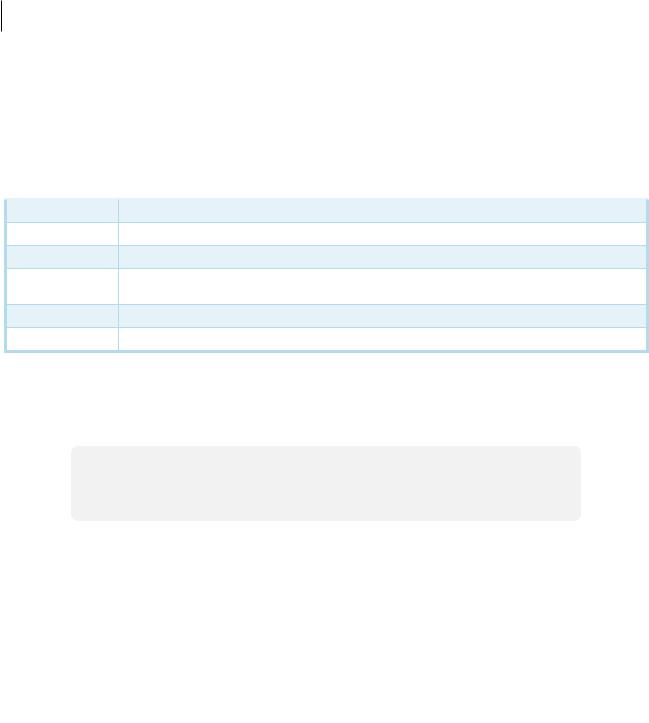
ii
About This User’s Manual
This manual provides detailed instructions on how to set up, use, manage, and maintain Atrust t66 thin clients.
Manual Structure and Subjects
Chapter |
Subject |
|
|
1Provides an overview of Atrust t66 thin clients.
2Provides detailed instructions on how to set up Atrust t66 thin clients.
3Provides the basics of how to use Atrust t66 thin clients.
4Provides instructions on how to configure client settings and customize Atrust t66 thin clients with the Atrust Client Setup console.
Appendices Provides supplementary instructions on the maintenance and upgrade of Atrust t66 thin clients.
Specifications |
Provides detailed information on key components of Atrust t66 thin clients. |
Notes, Tips, and Warnings
Throughout this manual, the notes, tips, and warnings in the following formats are used to provide important information, useful advice, and prevent injuries to you, damage to your devices, or loss of data on your system.
NOTE
• A note provides important information for a specific situation.
TIP
• A tip gives a piece of useful advice to perform a task more efficiently.
WARNING
• A warning provides crucial information that must be followed to prevent injuries to you, damage to your devices, or loss of data on your system.

iii
Style Conventions
The following styles are used throughout this manual while referring to operational items on input devices, hardware panels, or application interfaces.
Item |
Style |
Example |
|
|
|
|
|
keys on the keyboard |
bold |
Ctrl + F2, Alt + F9, Alt + Tab |
|
|
|
|
|
application windows or |
first letter |
Confirm Dialog window, RDP Connection list, ICA Connection list, |
|
entry lists |
capitalized |
View Connection list |
|
|
|
|
|
buttons or tabs on a |
|
OK, Next, Save, Applications tab |
|
window, toolbars, taskbar, |
bold |
||
or menu |
|
|
|
|
|
|
|
options on a window, |
bold |
Add, Domain, Connection Type, High Quality |
|
screen, list, or menu |
|||
|
|
||
|
|
|
|
|
|
Applications > Citrix ICA, Applications > Remote Desktop, |
|
selecting a series of options |
bold |
Applications > VMware View, Network > Wireless, |
|
|
|
Devices > Printer, System > Time Zone |
|
|
|
|

iv
Safety and Regulatory Information
Regulatory Statement
Federal Communications Commission Interference Statement
This equipment has been tested and found to comply with the limits for a Class B digital device, pursuant to Part 15 of the FCC Rules. These limits are designed to provide reasonable protection against harmful interference in a residential installation. This equipment generates, uses and can radiate radio frequency energy and, if not installed and used in accordance with the instructions, may cause harmful interference to radio communications. However, there is no guarantee that interference will not occur in a particular installation. If this equipment does cause harmful interference to radio or television reception, which can be determined by turning the equipment off and on, the user is encouraged to try to correct the interference by one of the following measures:
•Reorient or relocate the receiving antenna.
•Increase the separation between the equipment and receiver.
•Connect the equipment into an outlet on a circuit different from that to which the receiver is connected.
•Consult the dealer or an experienced radio/TV technician for help.
FCC Caution: Any changes or modifications not expressly approved by the party responsible for compliance could void the user’s authority to operate this equipment. This device complies with Part 15 of the FCC Rules. Operation is subject to the following two conditions: (1) This device may not cause harmful interference, and (2) this device must accept any interference received, including interference that may cause undesired operation.
IMPORTANT NOTE:
FCC Radiation Exposure Statement
This equipment complies with FCC radiation exposure limits set forth for an uncontrolled environment. This equipment should be installed and operated with minimum distance 20 cm between the radiator & your body.
This transmitter must not be co-located or operating in conjunction with any other antenna or transmitter.

v
Regulatory Information
WEEE (Waste Electrical and Electronic Equipment) Directive
In the European Union, this symbol indicates that this product should not be disposed of with household waste. It should be deposited at an appropriate facility to enable recovery and recycling. For proper disposal, please contact your local recycling or hazardous waste center.
Safety Information
WARNING
• Use only power supplies listed in the user instructions.
WARNING
• Don’t use a keyboard and mouse that in total require more than 200 mA of rated current during operation.
WARNING
• For safety, do not make mechanical or electrical modifications to the equipment.
•Do not remove equipment covers and access any of the components inside the equipment. Any access inside the equipment without an authorized or certified technician may cause serious injuries and damage. For any problem, contact your dealer for assistance.
•You should only make repairs as authorized by the product documentation. Repairs, replacement, expansion, and upgrades not performed by a certified service technician may cause injuries to you, damage your system, and void your warranty.

vi

vii
Table of Contents
Copyright and Trademark Statements |
i |
|||
Disclaimer |
i |
|
|
|
Trademark Statements |
i |
|
|
|
About This User’s Manual |
ii |
|
||
Manual Structure and Subjects |
ii |
|
||
Notes, Tips, and Warnings |
|
ii |
|
|
Style Conventions |
iii |
|
|
|
Safety and Regulatory Information iv |
|
|||
Regulatory Statement |
iv |
|
|
|
Regulatory Information |
v |
|
|
|
Safety Information |
v |
|
|
|
1 Overview 1
1.1Introduction 3
|
1.2 |
Features |
3 |
|
|
|
|
|
|
|
|
1.3 |
Package Contents |
4 |
|
|
|
|
|
||
|
1.4 |
Exterior Views |
|
4 |
|
|
|
|
|
|
|
1.5 |
Panel Components |
5 |
|
|
|
|
|
||
|
1.6 |
LED Indicators |
|
7 |
|
|
|
|
|
|
2 |
Setting Up Your t66 |
9 |
|
|
|
|
|
|||
|
2.1 |
Positioning Your t66 |
11 |
|
|
|
|
|
||
|
2.2 |
Assembling the AC Adapter |
13 |
|
|
|
|
|||
|
2.3 |
Getting Connected |
13 |
|
|
|
|
|
||
3 |
Getting Started |
15 |
|
|
|
|
|
|
||
|
3.1 |
Learning the Basics |
17 |
|
|
|
|
|
||
4 |
Configuring Client Settings |
35 |
|
|
|
|
||||
|
4.1 |
Atrust Client Setup |
37 |
|
|
|
|
|
||
|
|
4.1.1 |
Interface Overview |
|
37 |
|
|
|
|
|
|
|
4.1.2 |
Client Settings at a Glance |
38 |
|
|
|
|
||
|
4.2 |
Configuring System Settings |
|
39 |
|
|
|
|||
|
|
4.2.1 |
System Tab Overview |
39 |
|
|
|
|
||
|
|
4.2.2 |
Available Settings at a Glance |
40 |
|
|
|
|||
|
|
4.2.3 |
Configuring Time Zone and Time Server |
41 |
|
|
||||
|
|
4.2.4 |
Configuring the Access Privileges and Passwords of Atrust Client Setup |
42 |
||||||
|
|
4.2.5 |
Configuring Shadow Settings for Remote Assistance |
44 |
|
|||||
|
|
4.2.6 |
Updating Firmware from the Management Computer |
46 |
|
|||||
|
|
4.2.7 |
Enabling or Disabling the Appliance Mode |
48 |
|
|
||||
|
|
4.2.8 |
Enabling or Disabling Auto Setup |
52 |
|
|
|
|||
|
|
4.2.9 |
Enabling or Disabling the Quick Connection Mode |
52 |
|
|||||
|
|
4.2.10 |
Configuring Advanced Quick Connection Settings |
55 |
|
|||||
|
|
4.2.11 |
Enabling or Disabling the Command-line Functions |
59 |
|
|||||
|
|
4.2.12 |
Collecting Event Logs and Capturing Related Screens |
60 |
|
|||||
|
|
4.2.13 |
Uploading Files for Error Reporting |
62 |
|
|
|
|||
|
|
4.2.14 |
Importing Certificates for Remote Computers |
63 |
|
|
||||
|
|
4.2.15 |
Enabling or Disabling Auto Registration |
67 |
|
|
||||
viii |
|
|
|
|
|
|
|
|
|
|
|
|
|
|
|
|
|
||
|
|
|
|
|
|
|
|
|
|
|
|
|
4.2.16 |
Viewing System Information |
|
68 |
|
|
|
|
4.3 |
Configuring User Interface Settings |
69 |
|
|
|
|||
|
|
|
4.3.1 |
User Interface Tab Overview |
|
69 |
|
|
|
|
|
|
4.3.2 |
Available Settings at a Glance |
70 |
|
|
|
|
|
|
|
4.3.3 |
Configuring Display Settings |
|
70 |
|
|
|
|
|
|
4.3.4 |
Customizing Desktop and System Language Settings |
72 |
|
|||
|
|
|
4.3.5 |
Hiding or Showing Quick Access Shortcuts |
74 |
|
|
||
|
|
|
4.3.6 |
Using a Custom Wallpaper |
75 |
|
|
|
|
|
|
|
4.3.7 |
Adjusting Keyboard Settings |
|
76 |
|
|
|
|
|
|
4.3.8 |
Configuring Mouse Settings |
|
78 |
|
|
|
|
|
|
4.3.9 |
Configuring Screensaver Settings |
79 |
|
|
|
|
|
4.4 |
Configuring External Device Settings |
|
80 |
|
|
|||
|
|
|
4.4.1 |
Devices Tab Overview |
80 |
|
|
|
|
|
|
|
4.4.2 |
Available Settings at a Glance |
81 |
|
|
|
|
|
|
|
4.4.3 |
Configuring Settings for USB Storage Devices |
81 |
|
|
||
|
|
|
4.4.4 |
Manually Mount and Eject Attached USB Storage Devices |
|
82 |
|||
|
|
|
4.4.5 |
Disabling or Enabling Attached Audio Devices |
83 |
|
|
||
|
|
|
4.4.6 |
Adding a Local Printer |
84 |
|
|
|
|
|
|
|
4.4.7 |
Adding a Network Printer |
87 |
|
|
|
|
|
4.5 |
Configuring Network Settings |
88 |
|
|
|
|||
|
|
|
4.5.1 |
Network Tab Overview |
88 |
|
|
|
|
|
|
|
4.5.2 |
Available Settings at a Glance |
89 |
|
|
|
|
|
|
|
4.5.3 |
Configuring Wired Network Settings |
90 |
|
|
|
|
|
|
|
4.5.4 |
Enabling or Disabling Wake On LAN |
93 |
|
|
|
|
|
|
|
4.5.5 |
Establishing and Stopping a VPN connection |
94 |
|
|
||
|
|
|
4.5.6 |
Configuring Virtual Private Network Settings |
98 |
|
|
||
|
|
|
4.5.7 |
Creating the Mapping of IP Addresses to Names of Hosts |
|
99 |
|||
|
|
|
4.5.8 |
Configuring the Failover Cluster List |
101 |
|
|
|
|
|
|
|
4.5.9 |
Changing the Host Name of Your Thin Client |
103 |
|
|
||
|
|
|
4.5.10 |
Enabling or Disabling the Wireless Interface |
104 |
|
|
||
|
|
|
4.5.11 |
Configuring the Trigger Threshold for Roaming |
|
105 |
|
||
|
|
|
4.5.12 |
Establishing and Stopping a Wireless Connection |
106 |
|
|||
|
|
|
4.5.13 |
Configuring Wireless Connection Settings |
109 |
|
|
||
|
|
|
4.5.14 |
Configuring Proxy Settings for Web-based Access to Services |
110 |
||||
|
4.6 |
Configuring Service Access Settings |
|
112 |
|
|
|||
|
|
|
4.6.1 |
Applications Tab Overview |
112 |
|
|
|
|
|
|
|
4.6.2 |
Available Settings at a Glance |
113 |
|
|
|
|
|
|
|
4.6.3 |
Configuring Basic RDP Connection Settings |
114 |
|
|
||
|
|
|
4.6.4 |
Accessing Remote Desktop Services |
123 |
|
|
|
|
|
|
|
4.6.5 |
Configuring Advanced RDP Connection Settings |
129 |
|
|||
|
|
|
4.6.6 |
Configuring Basic ICA Connection Settings |
145 |
|
|
||
|
|
|
4.6.7 |
Switching the Citrix Receiver Version |
158 |
|
|
|
|
|
|
|
4.6.8 |
Enabling or Disabling Esc to Quit on the Web Logon Screen |
159 |
||||
|
|
|
4.6.9 |
Configuring Keyboard Layout and Type for Citrix ICA Sessions |
160 |
||||
|
|
|
4.6.10 |
Accessing Citrix Services |
161 |
|
|
|
|
|
|
|
4.6.11 |
Configuring Advanced ICA Connection Settings |
|
168 |
|
||
|
|
|
4.6.12 |
Configuring Basic VMware View Connection Settings |
197 |
|
|||
|
|
|
4.6.13 |
Accessing VMware View or Horizon View Services |
199 |
|
|||
|
|
|
4.6.14 |
Configuring Advanced View Connection Settings |
201 |
|
|||
|
|
|
4.6.15 |
Configuring SSH Connection Settings |
|
205 |
|
|
|
|
|
|
4.6.16 |
Launching SSH and Telnet Sessions |
207 |
|
|
|
|
|
|
Appendices |
209 |
|
|
|
|
|
|
A.1 |
Resetting Your t66 to the Factory Default 211 |
|
|
A.2 |
Updating Firmware for Your t66 with a USB Flash Drive |
212 |
|
A.3 |
Using SECUREMATRIX Authentication for VMware Connections |
215 |
|
Specifications 223

1
Overview
This chapter provides an overview of Atrust t66 thin clients.
1.1 |
Introduction |
|
|
Desktop virtualization and simple endpoint devices |
3 |
1.2 |
Features |
|
|
Key features of Atrust t66 |
3 |
1.3 |
Package Contents |
|
|
Check your package contents |
4 |
1.4 |
Exterior Views |
|
|
Overview of thin client outside elements |
4 |
1.5 |
Panel Components |
|
|
Descriptions of front and rear panel components |
5 |
1.6 |
LED Indicators |
|
|
Descriptions of signals for LED indicators |
7 |

Overview 3
Introduction
1.1Introduction
Desktop virtualization provides a new perspective to reconsider the design and implementation of an IT infrastructure. In a desktop virtualization infrastructure, a station is no longer a cumbersome desktop, but simply an endpoint device for users to access delivery services from the server(s).
With the introduction of the desktop virtualization technologies, you can considerably benefit from:
•On-demand applications/desktops
•Centralized management of work environments
•Drastically reduced endpoint software/hardware issues
•Simplified system maintenance and Improved system security
•More scalability with low-cost endpoint devices
1.2Features
The key features of Atrust t66 thin clients are:
•Support for a wide range of desktop virtualization solutions from industry-leading companies:
ŹŹMicrosoft® Remote Desktop
ŹŹCitrix® XenApp™, XenDesktop®, and VDI-in-a-Box™
ŹŹVMware® View™ and Horizon View™
•Support for high-definition technologies:
ŹŹMicrosoft® RemoteFX®
ŹŹCitrix® HDX™
ŹŹVMware® View™ PCoIP®
•Simple click-access to various applications/desktops
•Built-in Atrust Client Setup as the local client management console
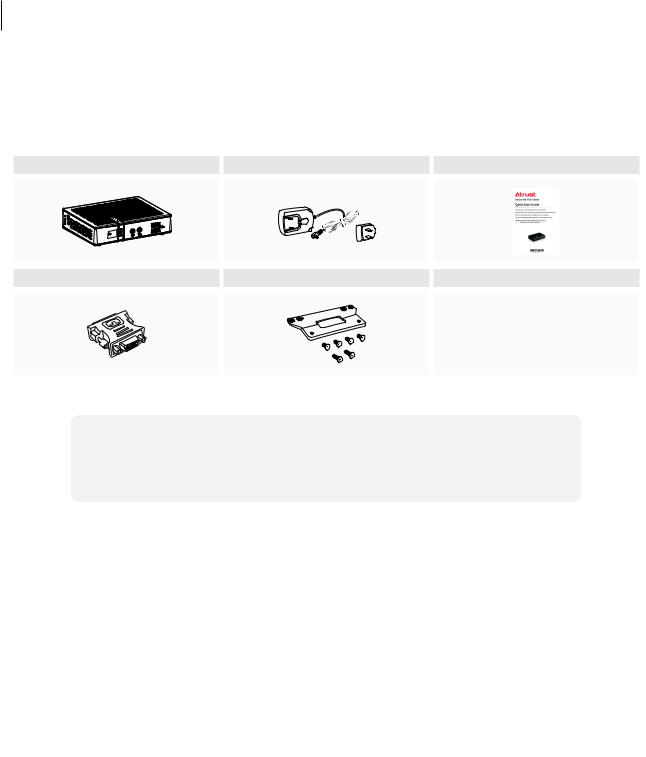
4 Overview
Package Contents
1.3Package Contents
Please check your package contents. Ensure that all of the items are present in your package. If any items are missing or damaged, please contact your dealer immediately.
Atrust t66 |
AC adapter |
Quick Start Guide |
||
|
|
|
|
|
|
|
|
|
|
DVI-I to VGA adapter |
VESA mount kit (Optional) |
NOTE
• Your package may not contain a hard copy of the Quick Start Guide. In this case, a soft copy in PDF format will be provided.
1.4Exterior Views
Left front view |
Right rear view |
Front Panel |
Rear Panel |
Kensington |
|
||
|
|
lock slot |
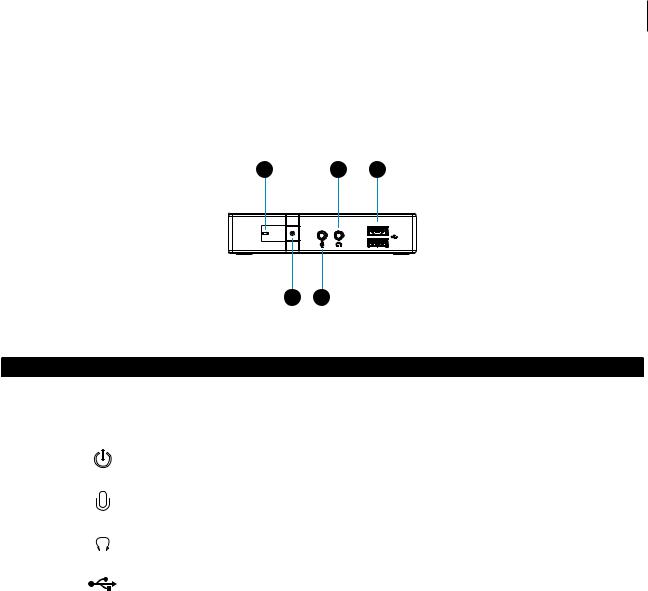
Overview 5
Panel Components
1.5Panel Components
1 |
4 |
5 |
2 3
Front Panel Components
No. |
Sign |
Name |
Description |
||
1 |
|
|
|
Power LED |
Indicates the status of power. |
|
|
|
|
|
|
|
|
|
|
|
• Press to power on the thin client. |
2 |
|
|
|
Power button |
• Press to exit the Sleep mode. |
|
|
|
|
|
• Long press to force power off the thin client. |
3 |
|
|
|
Microphone port |
Connects to a microphone. |
|
|
|
|||
|
|
|
|
|
|
|
|
|
|
|
|
4 |
|
|
|
Headphone port |
Connects to a set of headphones or a speaker system. |
|
|
|
|
|
|
5 |
|
|
|
USB port |
Connects to a USB device. |
|
|
|
|
|
|
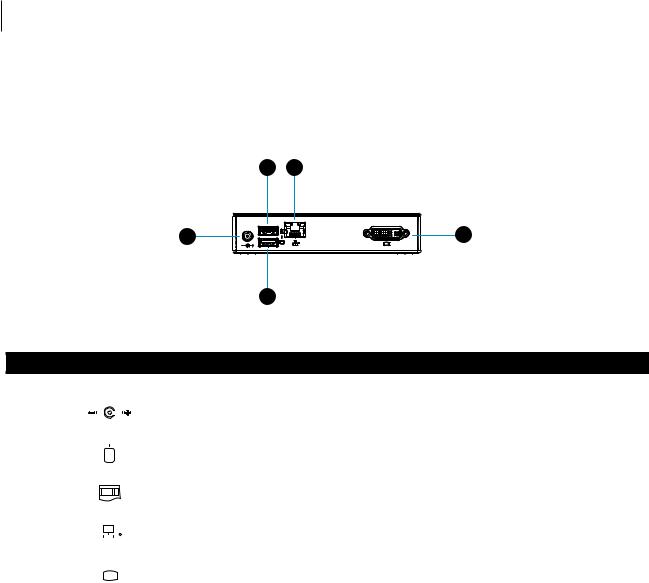
6 Overview
Panel Components
7 9
6 |
10 |
8
Rear Panel Components
No. |
Sign |
Component Name |
Description |
|||||||
6 |
|
|
|
|
|
|
|
|
DC IN |
Connects to an AC adaptor. |
|
|
|
|
|
|
|
|
|||
|
|
|
|
|
|
|
|
|
|
|
7 |
|
|
|
|
|
|
|
|
USB port |
Connects to a mouse. |
|
|
|
|
|
|
|
|
|||
|
|
|
|
|
|
|
|
|||
|
|
|
|
|
|
|
|
|
|
|
8 |
|
|
|
|
|
|
|
|
USB port |
Connects to a keyboard. |
|
|
|
|
|
|
|
|
|
|
|
9 |
|
|
|
|
|
|
|
|
LAN port |
Connects to a network. |
|
|
|
|
|
|
|
|
|||
|
|
|
|
|
|
|
|
|
|
|
10 |
|
|
|
|
|
|
|
|
DVI-I port |
Connects to a monitor. |
|
|
|
|
|
|
|
|
|||
|
|
|
|
|
|
|
|
|
|
|
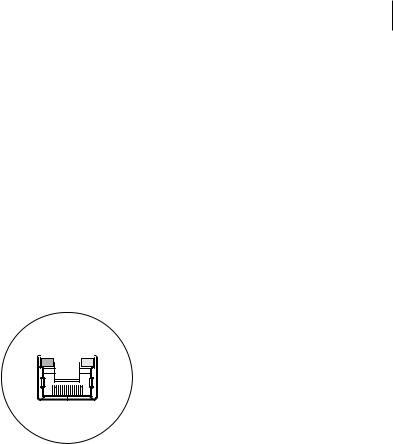
Overview 7
LED Indicators
1.6LED Indicators
Your t66 is equipped with a Power LED to indicate the state of power. The meanings of LED signals are described as follows:
LED |
Signal |
Meaning |
|
Off |
The client is off. |
|
|
|
Power LED |
Blue |
The client is on. |
|
Orange |
The client is in Sleep mode. |
The LAN port of your t66 is equipped with two LED indicators, showing the status of networking. The meanings of LED signals of the LAN port are described as follows:
SPEED LED 



 LINK/ACT LED
LINK/ACT LED
|
SPEED LED |
LINK/ACT LED |
Meaning |
|
|
(transmission rate) |
(linking/transmission activity) |
||
|
|
|||
|
|
|
|
|
|
Off |
Off |
The client is not connected to a LAN. |
|
LED Signal |
Off |
Amber blinking |
The client connects to a 10 Mbps LAN. |
|
Orange |
Amber blinking |
The client connects to a 100 Mbps LAN. |
||
|
||||
|
Green |
Amber blinking |
The client connects to a 1000 Mbps LAN. |

8 Overview

2
Setting Up Your t66
This chapter provides detailed instructions on how to set up your t66 thin client.
2.1 Positioning Your t66 |
|
To mount your t66 |
|
Step 1: Understand Your VESA Mount Kit for t66 |
11 |
Step 2: Mount Your t66 |
12 |
2.2 |
Assembling the AC Adapter |
|
|
How to assemble the AC adapter and its detached plug |
13 |
2.3 |
Getting Connected |
|
|
How to connect peripherals and power for t66 |
13 |

Setting Up Your t66 11
Positioning Your t66
2.1Positioning Your t66
There are two ways to position your t66:
•Put it on a desk or a desired place horizontally.
•Mount it on the back of a monitor using a VESA mount kit.
NOTE
• The VESA mount kit is an optional accessory for your t66. Your package may not contain a VESA mount kit. Contact your dealer if needed.
To mount your t66 on the back of a monitor, please follow the steps below:
Step 1: Understand Your VESA Mount Kit for t66
Step 2: Mount Your t66
Step 1: Understand Your VESA Mount Kit for t66
Your t66’s VESA mount kit consists of a bracket and six screws.
Mount bracket
Six screws with two types
Mount Bracket
Refer to the following figure and descriptions for the VESA mount holes on the mount bracket for t66.
1 |
1 |
2 |
2 |
3 |
3 |
Mount Hole Description
1The VESA mount holes used to secure the bracket to your t66.
2The VESA mount holes (with the distance of 100 mm) used to secure the bracket to a monitor.
3The VESA mount holes (with the distance of 75 mm) used to secure the bracket to a monitor.
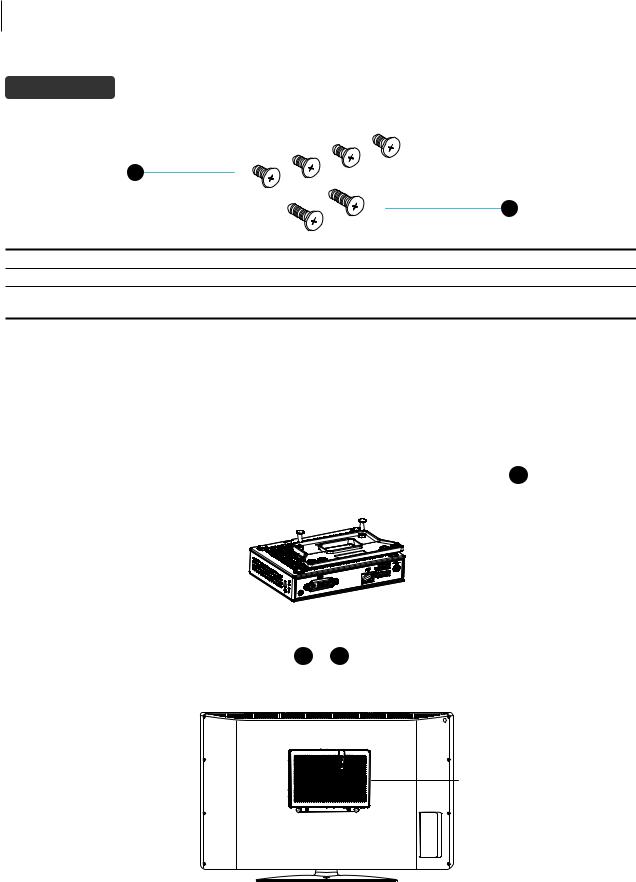
12 Setting Up Your t66
Positioning Your t66
Mount Screws
1
|
|
2 |
|
Screw Type |
Number |
Description |
|
1 |
4 |
The screws used to secure the bracket to your t66 and to a monitor. |
|
2 |
2 |
The longer screws used to secure the bracket to a monitor if the screws of type 1 |
|
cannot firmly secure the bracket and your t66 to the monitor. |
|||
|
|
Step 2: Mount Your t66
To mount your t66 on the back of the monitor, please do the following:
1.Place your t66 on a flat surface with the VESA mount hole side upward.
2.With the bracket side marked with Atrust facing downward, align two mount holes on the bracket with two
mount holes on your t66 such that the bracket projects out and is closer to the rear panel than the front one as shown below, and then secure the bracket to your t66 with two (2) screws of type 1 .
3. Align the mount holes on the bracket with the mount holes on the back of the monitor, and then secure the
bracket to the monitor with two (2) screws of 1 or 2 . Ensure that the rear panel of your t66 is facing downward as shown below.
Have t66’s rear panel facing downward.

Setting Up Your t66 13
Assembling the AC Adapter
2.2Assembling the AC Adapter
To assemble the AC adapter for your t66, please do the following:
1. Unpack your thin client package and take out the AC adapter and its detached plug.
2. Slide the plug into the AC adapter until it clicks into place.
NOTE
• The supplied plug may vary, depending on different areas.
2.3Getting Connected
To make connections for your t66, please do the following:
1.Connect your t66 to your local network with an Ethernet cable.
2.Connect a keyboard and mouse to your t66.
3.Connect and turn on the monitor.
NOTE
• In case that only the VGA monitor is available, use the supplied DVI-I to VGA adapter to connect your t66 and monitor.
•Please note that you need to connect and turn on your monitor before powering up your thin client. Otherwise, the client may fail to set an appropriate resolution for the monitor.
4.Connect your t66 to a power outlet using the AC adapter included in the package.
NOTE
• For detailed instructions on how to assemble the supplied AC adapter, please refer to section “2.2 Assembling the AC Adapter” on page 13.
5. Connect other peripherals for your t66 if needed.

14 Setting Up Your t66

3
Getting Started
This chapter provides the basics of how to use your t66.
3.1 Learning the Basics |
|
Topic 1: Powering On Your t66 |
18 |
Topic 2: Configuring the Time Zone |
19 |
Topic 3: Returning to the Quick Connection Screen |
20 |
Topic 4: Accessing Desktops or Applications |
21 |

Getting Started 17
Learning the Basics
3.1Learning the Basics
The following topics will guide you through the basics of using your t66:
Topic 1: Powering On Your t66
Topic 2: Configuring the Time Zone
Topic 3: Returning to the Quick Connection Screen (if needed)
Topic 4: Accessing Desktops or Applications
•Microsoft Remote Desktop Services (RDP sessions)
•Citrix Services (ICA sessions)
•VMware View or Horizon View Services (View sessions)
NOTE
• Three client modes are available for your t66:
No. |
Mode |
Description |
||
|
|
|
||
|
|
The client will start up directly with the desired |
||
|
|
RDP / ICA / View session and perform the |
||
|
|
configured action after exiting the session. |
||
1 |
Appliance |
Available actions include: |
||
• |
Re-launching a new session |
|||
|
|
|||
|
|
• |
Restarting the thin client |
|
|
|
• |
Turning off the thin client |
|
The client will start up directly with the desired RDP / ICA / View session and perform the configured action after exiting the session.
Available actions include:
2 |
Autostart |
• |
Returning to the local desktop |
|
|
||
|
|
• |
Re-launching a new session |
|
|
• |
Restarting the thin client |
|
|
• |
Turning off the thin client |
|
|
|
|
3 |
Quick Connection |
The default. The client will enter Atrust Quick |
|
Connection screen after system startup. |
|||
•In Quick Connection mode, you can access Microsoft Remote Desktop /Citrix / VMware View or Horizon View services quickly without much client configuration required. The main purpose of this chapter is to guide you through the use of your t66 under the Quick Connection mode.
•To understand other modes, configure advanced settings, and customize your t66, please refer to chapter 4 “Configuring Client Settings” on page 35.
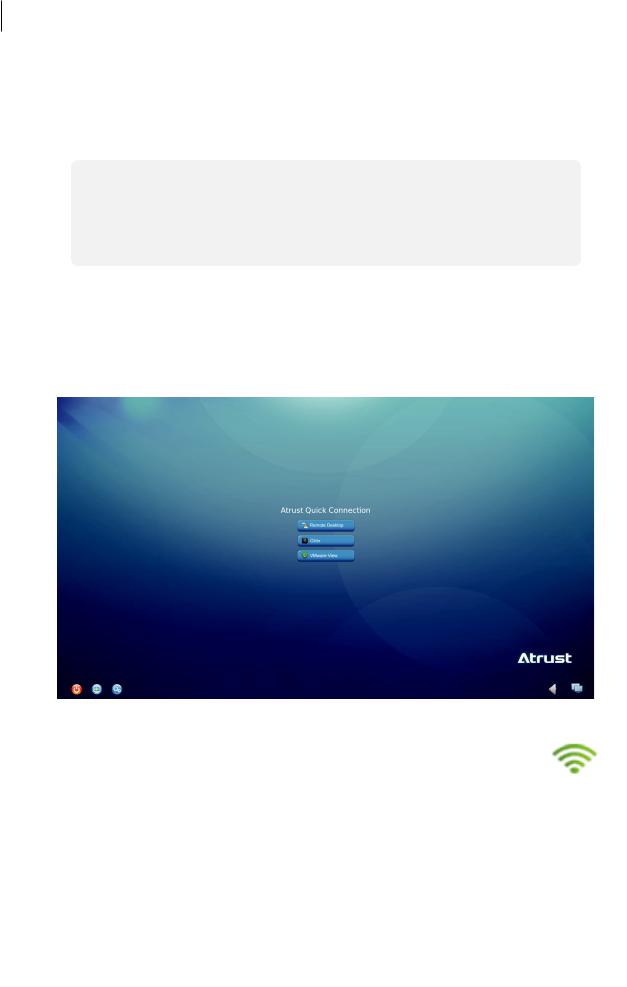
18 Getting Started
Learning the Basics
Topic 1: Powering On Your t66
To start using your t66, please do the following:
1. Ensure that your monitor is connected and turned on.
NOTE
• Please note that you need to connect and turn on your monitor before powering up the thin client. Otherwise, the client may fail to set an appropriate resolution for the connected monitor.
2.Press the Power button to turn on the client. Wait a moment for Atrust Quick Connection screen to appear.
3.(a) Go to Topic 2 to set the time zone for the first time use.
(b) Go to Topic 4 if the time zone had been set.
Atrust Quick Connection Screen
|
|
|
|
|
|
Mixer |
Network |
|
|
|
|
|
|
|
|
|
|
||
|
|
|
|
|
|
|
|
||
|
|
|
|
|
|
|
|
|
|
|
|
|
|
|
|
|
|
|
|
Power Off |
Click the icon to suspend, shut down, or restart the system. |
|
|
|
|||||
|
|
|
|
|
|
|
|
|
|
Local Desktop |
Click the icon to enter the local Linux desktop. |
|
|
|
|||||
To return to this screen from the local Linux desktop, see Topic 3. |
|
|
|
||||||
|
|
|
|
|
|
|
|||
|
|
|
|
|
|
|
|
|
|
Setup |
Click the icon to launch Atrust Client Setup. |
|
|
|
|||||
|
|
|
|
|
|
|
|
|
|
Mixer |
Click the icon to configure audio settings. |
|
|
|
|||||
|
|
|
|
|
|
|
|
|
|
Network |
Indicates the network type (wired or wireless) and status. |
|
|
|
|||||
Click the icon to configure network settings. |
|
|
|
||||||
|
|
|
|
|
|
|
|||
|
|
|
|
|
|
|
|
|
|
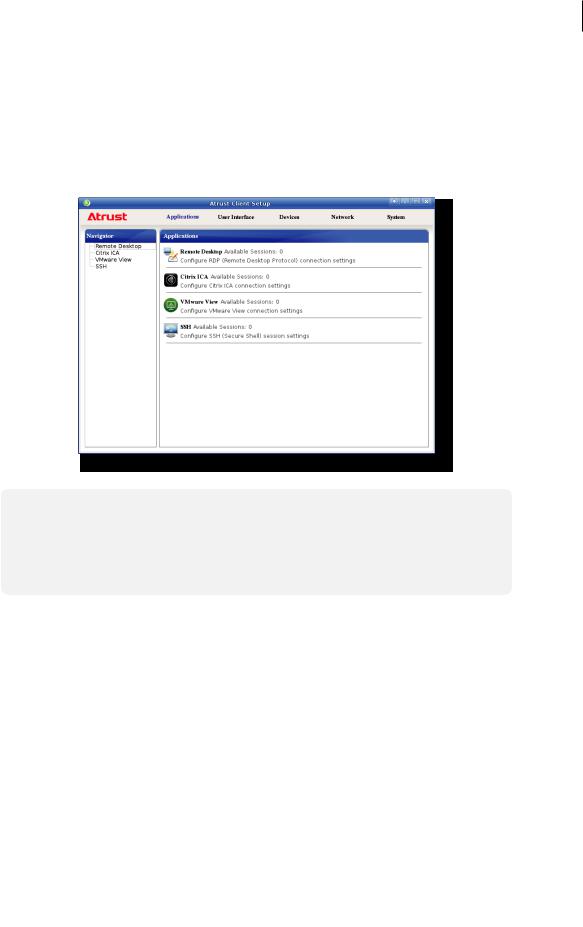
Topic 2: Configuring the Time Zone
To set the time zone for your t66, please do the following:
1. Click the Setup  icon to launch Atrust Client Setup.
icon to launch Atrust Client Setup.
Atrust Client Setup
Navigation Area
Click to select a setting item or entry.
Getting Started 19
Learning the Basics
Category Tabs
Click a tab to select a setting category.
NOTE
• For detailed instructions on how to configure client settings and customize your t66 with Atrust Client Setup, please refer to chapter 4 “Configuring Client Settings” on page 35.
2. On Atrust Client Setup, click System > Time Zone.
Time Zone drop-down menu
3.Click the Time Zone drop-down menu to select the desired time zone.
4.Click Save to apply, and then close Atrust Client Setup.

20 Getting Started
Learning the Basics
Topic 3: Returning to the Quick Connection Screen
To return to Atrust Quick Connection screen when on local Linux desktop, please double click
Atrust Quick Connection on that desktop.
Local Linux Desktop
Atrust Quick Connection
